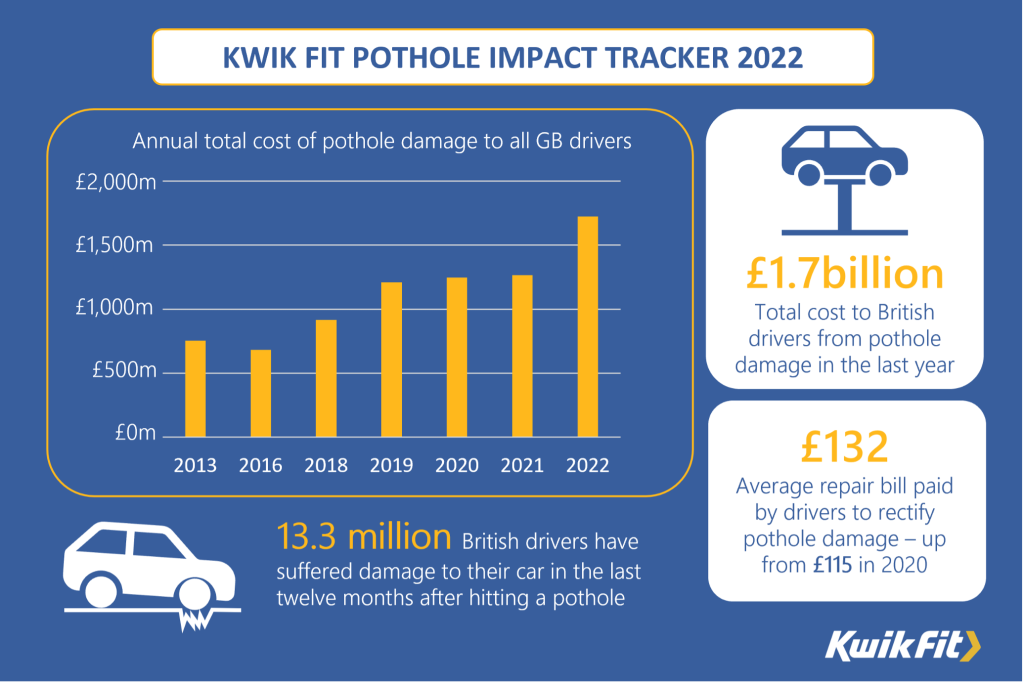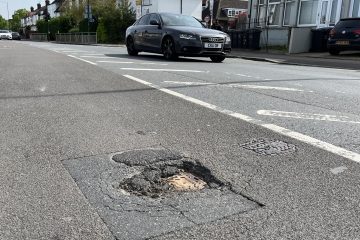The annual Pothole Impact Tracker (PIT) for Kwik Fit shows that over the last 12 months, the total cost of pothole damage to UK drivers has risen to £1.7 billion.
This figure is a 35% increase on damage reported in the year to March 2021, although the rise could be attributed to higher traffic levels following a year of lockdowns due to the COVID-19 pandemic. However, it is notable that the latest figure is nearly £500 million higher than in the year before Covid hit, despite average daily car traffic remaining below those pre-pandemic levels, and in fact is the biggest total seen since Kwik Fit began tracking the cost annually.

The number of British drivers experiencing pothole problems has risen, with 59% saying they have hit at least one a week over the last year, up from 46% in 2021. Around 13.3 million motorists say their car has suffered damage in the last year as a result of a pothole impact, with the average individual repair bill coming to £132.
Of those drivers who experienced damage after a pothole impact, the research found that 50% faced damage to their tyres. This was followed by wheel damage in 29% of cases, damaged suspension (also 29%) and steering (18%). For 12% of drivers facing damage, the impact was severe enough to cause bodywork problems, while for 10%, damage was caused to engine components.
Kwik Fit’s research has found that when it comes to the road surfaces in their local area, almost three times as many drivers think conditions have deteriorated in the last year as believe they have got better. 46% of drivers say the road surfaces have got worse in the last twelve months, compared to 16% who say they have improved. London is the only region of the country to buck this trend, with 30% of drivers saying the road surfaces are better than one year ago, compared to 25% who say they are worse.
Although the damage caused by a pothole may be instantly apparent, such as a burst tyre or cracked alloy, in many cases the effect can be hidden. The impact could lead to gradual deflation through a slow puncture, or cause a bulge or damage to the inside wall of a tyre that could result in a failure at high speed. Similarly, if wheels are knocked slightly out of alignment it can compromise handling and cause uneven tyre wear, but it may take time for this to become obvious. A hard hit could also cause damage to suspension springs, which may weaken and snap. Kwik Fit recommends drivers who have experienced a particularly heavy impact to keep a close eye on how their car is handling in the days following the incident.
“The total cost of potholes to the nation’s drivers is rising due to a combination of factors – worsening road surfaces, the impact of inflation on individual repair costs and car use getting back to near pre-pandemic levels,” said Roger Griggs, communications director at Kwik Fit. “We all know there are huge demands on public finances at the moment, but the reality is that drivers have been consistently calling for a strategic plan to effectively bring our roads up to scratch for many years. It is not sufficient to just carry out emergency patching of the worst areas – this is always going to be a case of papering over the cracks.
“If drivers have seen a pothole, we encourage them to report it as councils can only rectify a problem if they are aware of it. For England and Wales the Government has a central webpage which will direct drivers to the correct authority if they are unsure who is responsible, with the Scottish Government offering an equivalent service north of the border.”




You must be logged in to post a comment.